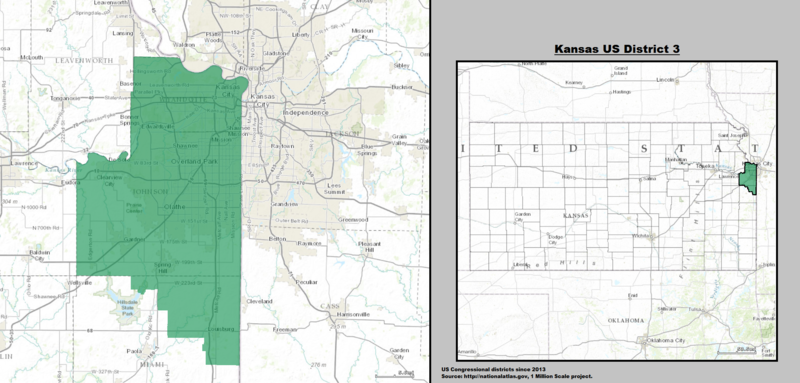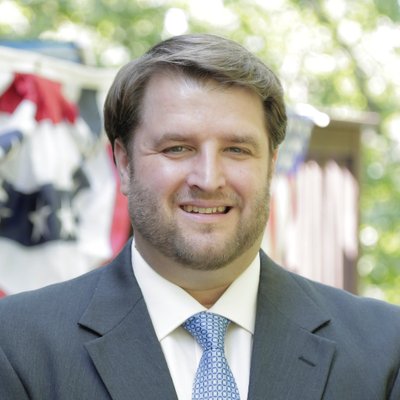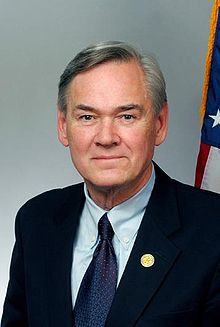The Democratic Bellwether-in Kansas?
 Kansas City, as seen from KS-03.
https://flic.kr/p/iiu3s4
Kansas City, as seen from KS-03.
https://flic.kr/p/iiu3s4
Each of the 435 US House districts contested in November has its own geographic, cultural, and political quirks. It remains difficult to develop sweeping conclusions from one district or another, but some show the interaction of various trends. For years, Democrats have targeted swingy educated suburbs. In many of these locales, where Hillary Clinton performed well, President Donald Trump is deeply unpopular, leading Democrats to see suburban potential for the 2018 midterm elections.
On August 7th, A major test of the Democrats’ newfound suburban strategy will come in Kansas’ Third US House District, which Hillary Clinton won in 2016 with 50.7% of the vote as incumbent Republican Congressman Kevin Yoder won with 51.3%. According to the 2016 American Community Survey, the Third District is 80.7% White, 8.3% Black, and 4.4% Asian, with 11.9% of the population being Hispanic, Whiter than the national average as well as more affluent. The median household income is $71,562, with 47.4% of residents possessing a bachelor’s degree or more, whereas the national median household income is $56,617 and 36% of Americans possess a bachelor’s degree or higher. Thus, the Third district fits the bill for one of the more affluent suburban districts Democrats are targeting. That being said, the Third district comprises three different counties–Wyandotte, Johnson, and a part of Miami–each of which has its own profile. Wyandotte County is a diverse, working-class Democratic County. Johnson County is a historically Republican, but increasingly Democratic, affluent suburban county; it casts a majority of votes in the district and is essential to victory, although it has not voted for a Democratic Presidential candidate since 1916. Hillary Clinton came within 3% of winning it. Finally, a tiny sliver of rural Republican Miami County is included in the district. Primary results here will be useful as a disaggregated picture of the party’s direction, while general election results will reveal the nature of Democrats’ suburban strategy overall.

https://tinyurl.com/y9as4ae8
So far, the 2018 election cycle has been a tumultuous season of primary scraps between the hard-left of the Democratic Party, demonstrated by figures like New York 14th District nominee Alexandria Ocasio-Cortez and the more moderate establishment wing, as seen by Congressman Joe Crowley, who she defeated. Fights like this one have played out across the country, with varying results. Moreover, the most centrist wing of the Democratic Party, the Blue Dog Coalition, appears to be a crucial part of the path to a House of Representatives majority. While some have taken these seemingly countervailing trends as signs of a party in disarray, they more likely point to a diverse party capable of adapting to different districts, a positive sign. However, when these trends merge, as they do in Kansas, the resulting election provides a good reading of the party’s momentum. Kansas’ Third District, with its 6 Democratic candidates, exemplifies the battle over the soul of the party as Democrats seek suburban support.
One of the Democratic frontrunners in this primary has attracted a disproportionately high degree of national attention. Brent Welder is a labor lawyer who led Bernie Sanders’ 2016 primary election effort in the Third District and formerly served as the National Field Director for the Teamsters Union. His left-wing platform, which includes single-payer universal healthcare, debt-free college, abolishing Immigration and Customs Enforcement (ICE), and a $15 national minimum wage, burnishes his leftist credentials. Recently, Vermont Senator Bernie Sanders and New York 14th District Candidate Alexandria Ocasio-Cortez appeared at a crowded rally for him.

https://pbs.twimg.com/profile_images/888221150525800450/PvQcF0rI_400x400.jpg
Welder raised over $100,000 in the week following this event, a substantial amount for that time span and leads the Democratic field in fundraising, with $734,042 raised thus far. A Public Policy Polling poll taken in February showed Welder hypothetically leading incumbent Republican Kevin Yoder 49%-42%. However, this poll was conducted long ago, before other Democratic frontrunners gained momentum, and doesn’t show how other candidates would perform. Democrats, including Welder’s wife, have alleged that Kevin Yoder is attempting to interfere in the primary by employing Facebook ads targeted at Democrats with a headline “Progressive Liberals Back Brent Welder”. They claim that Yoder does so out of fear of facing off against Welder. However, while this ad’s message is anathema to winning over Republicans and moderate independents, it may actually energize liberal Democrats to vote for Welder. This type of meddling is not unprecedented; Missouri Democratic Senator Claire McCaskill saw Todd Akin as the weakest Republican candidate in 2012, boosted his primary campaign with a similar ad, and then went on to defeat him handily in the general election. Thus, it appears that Kevin Yoder wants to face off against Brent Welder, perhaps sensing the weakness of a Missourian left-winger running in the Third. A Welder victory in the primary would undoubtedly energize the progressive wing of the party, but nominating such a left-leaning candidate in an affluent suburban district could prove risky, especially as Yoder attempts to cultivate a center-right image.
Other candidates, while attracting less national attention, are less polarizing and probably more threatening for Congressman Kevin Yoder’s re-election chances. One of the other three frontrunners, and definitely the most interesting candidate, is Sharice Davids. Davids is a Cornell Law School graduate, Obama White House Fellow, former mixed martial arts (MMA) fighter, and entrepreneur. As a member of the Ho-Chunk nation tribe, Davids would be the first Indigenous Woman in Congress. Additionally, she would be the first LGBTQ Representative from Kansas. Her background as the daughter of a single mother adds to her inspiring story, generating energy among progressives and especially young voters, whose political involvement has increased since President Donald Trump’s election. Despite this progressive-friendly background, Davids is more moderate on the issues than Brent Welder, proposing pragmatic ideas like Medicare drug price negotiation (but not single-payer healthcare), expanded firearm background checks, and protection of Dreamers, but not necessarily abolishment of ICE. She also garnered the endorsement of pro-choice lobbying group Emily’s List, which has spent $400,000 on ads for Davids, who has raised $345,304 herself, a respectable amount, even if less than the other frontrunners. Davids unites both progressives enamored with her story and moderates willing to go with her policies. Thus, classifying her as belonging solely to one faction of the party is difficult, but perhaps this very flexibility, along with her outsider status, makes her an even stronger candidate.
The most moderate of the frontrunners is Tom Niermann, a Johnson County teacher. Niermann’s fundraising barely trails Welder’s, and his endorsements include the centrist Mainstream Coalition and even Republican State Senator Barbara Bollier. Niermann emphasizes values like listening and bipartisanship that demonstrate his approach. He is a strong and charismatic speaker who continually underlines his support for education. Traditionally, education is a popular issue in suburbs, and it has formed the core of many campaigns in Kansas, where state Republicans slashed public school funding to the bone. Niermann’s uncontroversial approach, strong fundraising, and attractive qualities make him a frontrunner, but the question remains whether or not he can excite the party’s progressive wing in the primary. Niermann would certainly be a strong candidate in the general election with his crossover appeal and resembles the kind of candidate Democrats usually nominate in suburban districts; he is, at the very least, a safe choice.
The three other candidates possess various strengths and weaknesses, but only one of them approaches frontrunner status. Sylvia Williams, a banker, is running on business credentials paired with a moderate, yet innovative platform that includes issues like reinvestment in low-income areas. She has raised almost as much as Shaice Davids, but many media discussions exclude her from the frontrunners, which in turn harms her chances. This is despite the fact that her campaign is led by former State Senator and Third District Candidate Kelly Kultala and former Kansas Democratic Party Chair and Topeka Mayor Joan Wagnon, two experienced figures in Kansas politics. Williams could be poised for a dark horse victory, and her profile fits the district well. Another candidate is Mike McCamon, whose slogan is, quite aptly, “leading from the center”. Mike appears to be the most centrist of all the candidates, noting, “it’s not that he [Congressman Yoder] and President Trump are wrong on every single issue”. His platform, however, is quirky, including a ban on gasoline cars by 2040 and a luxury tax on political candidates who spend large amounts of money. McCamon and his frequent social media posts are unlikely to prevail in the primary, despite his clever #OverYoder signs. McCamon is joined by 2016 nominee Jay Sidie, whose fundraising has underwhelmed as his campaign never quite took off this cycle. Of course, nothing can be ruled out in a competitive primary where the vote can split many ways. It’s not impossible that Sidie wins based on name recognition from his last campaign, but the positioning of three (and a half?) frontrunners is clear.

https://commons.wikimedia.org/w/index.php?curid=10402191
As noted, the ideological factions of the Democratic Party are well-represented in this district, and each candidate is likely to do better than the rest with a particular segment of the district. Welder will probably succeed among labor union-affiliated voters in Wyandotte County, while Davids will presumably win over many young voters, and Niermann will likely shine in affluent portions of Johnson County. How this primary ends could be indicative of the Democrats’ overall direction in suburbia. Will suburban Democrats back a leftist candidate when given many options? Or will moderates prevail? Will the “year of the woman” continue?
Instead, moderates likely have a better chance of winning this seat in 2018 and beyond. After all, Blue Dog Democrat Dennis Moore represented the Third District from 1998 to 2010. He was the last Democrat to defeat an incumbent Republican Congressman in the Third District, and did so by painting incumbent Congressman Vince Snowbarger as a right-wing extremist, while portraying himself as a fiscally responsible centrist. Moore supported reasonable gun control, abortion rights, and cutting wasteful government spending. Before Snowbarger, the district had been represented by Representative Jan Meyers, a moderate, pro-choice Republican who reflected the district’s socially moderate, fiscally center-right outlook. Once elected, Dennis Moore defeated right-wing socially conservative candidates like future Secretary of State Kris Kobach and future Attorney General Phil Kline. This history in the Third District of moderate victories theoretically lays a smoother path to victory for a moderate Democrat, although undoubtedly the country has changed over the last 20 years and the Trump years represent a uniquely polarized time. In order to win the Third District, Democrats must maximize turnout in Wyandotte County and either win or come close in Johnson County. Therefore, a two-pronged strategy of exciting the Democratic base, which candidates like Brent Welder and Sharice Davids are good at, and winning over moderates, which Tom Niermann, Sharice Davids, and Sylvia Williams are poised to do, remains crucial. Additionally, even if Democrats win this seat in 2018, they would do well to pick a candidate who can continue to win the Third in non-wave years.
Thus, Sharice Davids appears to be the strongest candidate to face Kevin Yoder in November. Her pragmatism on the issues is likely to attract support from the suburbanites needed to win this district, while her background inspires progressives, people of color, and youth. Davids represents a smart direction for the Democratic Party-a more diverse, younger party, but not invariably a more radical one. This might be the key to making gains across a country suspicious of both open socialism and the Republican agenda. Bridging the divides within the Democratic Party will prove important over the coming years, and candidates like Sharice Davids show promise for swing districts. While her fundraising has not as of yet been as strong as Welder’s or Niermann’s, her dynamic campaign gives Davids a strong shot at winning the primary and, with united Democratic backing, defeating Kevin Yoder in November.
A close analysis of results by neighborhood on August 7th will allow observers to witness how each party faction performs among certain demographics. Results in union-heavy working class areas of Kansas City and rich Johnson County neighborhoods like Mission Hills will both be indicative of who party factions appeal to. November results here will probably support or undermine the notion that one particular candidate profile is well-made for red-state suburbs. Therefore, this otherwise random August race in the middle of the country is much more than another primary battle; it’s about the Democrats’ direction.
